Seismic Hazard Implications of the 2025 Balıkesir Earthquake of Mw 6.1 for Western Türkiye
Abstract
1. Introduction
2. Methodology
2.1. Seismicity of the Study Area and 2025-Sındırgı (Balıkesir) Earthquake (Mw = 6.1)
2.2. Comparison of Acceleration Spectra
3. Results
3.1. Comparative Analysis of Earthquake Hazard in Balıkesir Province
3.2. Field Damage Survey
4. Discussion
5. Conclusions
Author Contributions
Funding
Data Availability Statement
Conflicts of Interest
References
- Bilgin, H.; Hadzima-Nyarko, M.; Isik, E.; Ozmen, H.B.; Harirchian, E. A comparative study on the seismic provisions of different codes for RC buildings. Struct. Eng. Mech. 2022, 83, 195–206. [Google Scholar][Green Version]
- Gouliotis, L.; Papanikolaou, D. The Northern Giona Fault Zone, a major active structure through Central Greece. GeoHazards 2024, 5, 1370–1388. [Google Scholar] [CrossRef]
- Akhundzadah, N.A. Earthquake risk severity and urgent need for disaster management in Afghanistan. GeoHazards 2025, 6, 9. [Google Scholar] [CrossRef]
- Mantovani, E.; Viti, M.; Tamburelli, C.; Babbucci, D.; Baglione, M.; D’Intinosante, V. Seismicity patterns in some Mediterranean Zones after the 1939 Anatolian earthquake: Insights on Seismic Risk and the Tectonic Setting. GeoHazards 2025, 6, 29. [Google Scholar] [CrossRef]
- Mavroulis, S.; Mavrouli, M.; Sarantopoulou, A.; Antonarakou, A.; Lekkas, E. Increased preparedness during the 2025 Santorini–Amorgos (Greece) earthquake swarm and comparative insights from recent cases for civil protection and disaster risk reduction. GeoHazards 2025, 6, 32. [Google Scholar] [CrossRef]
- Işık, E.; Avcil, F.; Hadzima-Nyarko, M.; İzol, R.; Büyüksaraç, A.; Arkan, E.; Radu, D.; Özcan, Z. Seismic performance and failure mechanisms of reinforced concrete structures subject to the earthquakes in Türkiye. Sustainability 2024, 16, 6473. [Google Scholar] [CrossRef]
- Nanda, R.P.; Paul, N.K.; Chanu, N.M. Seismic loss estimation tool as a rapid survey for prioritizing buildings for disaster preparedness: Case study to hospital buildings. Nat. Hazards 2019, 95, 769–781. [Google Scholar] [CrossRef]
- Bulajić, B.; Lozančić, S.; Bajić, S.; Radu, D.; Işık, E.; Negovanović, M.; Hadzima-Nyarko, M. Horizontal UHS predictions for varying deep geology conditions—A case study of the city of Banja Luka. Sustainability 2025, 17, 6012. [Google Scholar] [CrossRef]
- Estêvão, J.M. Effectiveness of generative AI for post-earthquake damage assessment. Buildings 2024, 14, 3255. [Google Scholar] [CrossRef]
- Ozturk, M.; Arslan, M.H.; Korkmaz, H.H. Effect on RC buildings of 6 February 2023 Turkey earthquake doublets and new doctrines for seismic design. Eng. Fail. Anal. 2023, 153, 107521. [Google Scholar] [CrossRef]
- Naik, S.P.; Reicherter, K.; Kázmér, M.; Skapski, J.; Mohanty, A.; Kim, Y.S. Archeoseismic study of damage in Medieval Monuments around New Delhi, India: An approach to understanding paleoseismicity in an intraplate region. GeoHazards 2024, 5, 142–165. [Google Scholar] [CrossRef]
- Senkaya, M.; Erkan, E.F.; Silahtar, A.; Karaaslan, H. Implementation of clustering algorithms for damage prediction through seismic local-site parameters: 2023 Kahramanmaraş earthquake sequence. Bull. Earthq. Eng. 2024, 22, 6545–6566. [Google Scholar] [CrossRef]
- Feng, D.C.; Yi, X.; Deger, Z.T.; Liu, H.K.; Chen, S.Z.; Wu, G. Rapid post-earthquake damage assessment of building portfolios through deep learning-based component-level image recognition. J. Build. Eng. 2024, 98, 111380. [Google Scholar] [CrossRef]
- Arslan, M.H.; Dere, Y.; Ecemiş, A.S.; Doğan, G.; Özturk, M.; Korkmaz, S.Z. Code-based damage assessment of existing precast industrial buildings following the February 6th, 2023 Kahramanmaraş earthquakes (Pazarcık Mw 7.7 and Elbistan Mw 7.6). J. Build. Eng. 2024, 86, 108811. [Google Scholar] [CrossRef]
- Yuzbasi, J. Post-earthquake damage assessment: Field observations and recent developments with recommendations from the Kahramanmaraş earthquakes in Türkiye on February 6th, 2023 (Pazarcık M7.8 and Elbistan M7.6). J. Earthq. Eng. 2024, 1–26. [Google Scholar] [CrossRef]
- Işık, E.; Hadzima-Nyarko, M.; Tayeh, B.A.; Harrat, Z.R.; Avcil, F.; Arkan, E. Comparison of reinforcement methods with advanced materials for R/C columns. Adv. Eng. Lett. 2025, 4, 1–13. [Google Scholar] [CrossRef]
- Zhang, H.; Reuland, Y.; Shan, J.; Chatzi, E. Post-earthquake structural damage assessment and damage state evaluation for RC structures with experimental validation. Eng. Struct. 2024, 304, 117591. [Google Scholar] [CrossRef]
- Bozkurt, E. Neotectonics of Turkey–a synthesis. Geodin. Acta 2001, 14, 3–30. [Google Scholar] [CrossRef]
- Şengör, A.C.; Yilmaz, Y. Tethyan evolution of Turkey: A plate tectonic approach. Tectonophysics 1981, 75, 181–241. [Google Scholar] [CrossRef]
- Sborshchikov, I.M.; Savostin, L.A.; Zonenshain, L.P. Present plate tectonics between Turkey and Tibet. Tectonophysics 1981, 79, 45–73. [Google Scholar] [CrossRef]
- Bozkurt, E.; Mittwede, S.K. Introduction: Evolution of continental extensional tectonics of western Turkey. Geodin. Acta 2005, 18, 153–165. [Google Scholar] [CrossRef]
- Barka, A.A.; Kadinsky-Cade, K. Strike-slip fault geometry in Turkey and its influence on earthquake activity. Tectonics 1998, 7, 663–684. [Google Scholar] [CrossRef]
- Işık, E.; Ulutaş, H.; Büyüksaraç, A. The comparison of sectional damages in reinforced-concrete structures and seismic parameters on regional Basis; a case study from western Türkiye (Aegean Region). Earthq. Struct. 2023, 24, 37–51. [Google Scholar]
- Işık, E.; Harirchian, E.; Büyüksaraç, A.; Levent Ekinci, Y. Seismic and structural analyses of the eastern Anatolian region (Turkey) using different probabilities of exceedance. Appl. Syst. Innov. 2021, 4, 89. [Google Scholar] [CrossRef]
- Alkan, H.; Öztürk, S.; Bektaş, Ö.; Büyüksaraç, A. Statistical and seismotectonic analyses of the Marmara region under existing stress regime in the west of the NAFZ. Acta Geophys. 2025, 73, 1117–1136. [Google Scholar] [CrossRef]
- Bektaş, Ö.; Alkan, H.; Pırtı, A.; Yücel, M.; Büyüksaraç, A. Stress accumulation on the Karlıova (Bingöl) Triple Junction after two big earthquakes (Pazarcık-Ekinözü) in Turkey in 2023. Boll. Geofis. Teor. Appl. 2025, 66, 2. [Google Scholar]
- Reilinger, R.; McClusky, S.; Vernant, P.; Lawrence, S.; Ergintav, S.; Cakmak, R.; Ozener, H.; Kadirov, F.; Guliev, I.; Stepanyan, R.; et al. GPS constraints on continental deformation in the Africa-Arabia-Eurasia continental collision zone and implications for the dynamics of plate interactions. J. Geophys. Res. Solid Earth 2006, 111, B05411. [Google Scholar] [CrossRef]
- Emre, Ö.; Duman, T.Y.; Özalp, S.; Şaroğlu, F.; Olgun, Ş.; Elmacı, H.; Çan, T. Active fault database of Türkiye. Bull. Earthq. Eng. 2018, 16, 3229–3275. [Google Scholar] [CrossRef]
- Wessel, P.; Luis, J.F.; Uieda, L.; Scharroo, R.; Wobbe, F.; Smith, W.H.F.; Tian, D. The Generic Mapping Tools Version 6. Geochem. Geophys. Geosystems 2019, 20, 5556–5564. [Google Scholar] [CrossRef]
- Magliulo, G.; Ercolino, M.; Petrone, C.; Coppola, O.; Manfredi, G. The Emilia earthquake: Seismic performance of precast reinforced concrete buildings. Earthq. Spectra 2014, 30, 891–912. [Google Scholar] [CrossRef]
- Bournas, D.A.; Negro, P.; Taucer, F.F. Performance of industrial buildings during the Emilia earthquakes in Northern Italy and recommendations for their strengthening. Bull. Earthq. Eng. 2014, 12, 2383–2404. [Google Scholar] [CrossRef]
- Minghini, F.; Ongaretto, E.; Ligabue, V.; Savoia, M.; Tullini, N. Observational failure analysis of precast buildings after the 2012 Emilia earthquakes. Earthq. Struct. 2016, 11, 327. [Google Scholar] [CrossRef]
- Savoia, M.; Buratti, N.; Vincenzi, L. Damage and collapses in industrial precast buildings after the 2012 Emilia earthquake. Eng. Struct. 2017, 137, 162–180. [Google Scholar] [CrossRef]
- Valente, M.; Barbieri, G.; Biolzi, L. Damage assessment of three medieval churches after the 2012 Emilia earthquake. Bull. Earthq. Eng. 2017, 15, 2939–2980. [Google Scholar] [CrossRef]
- Valente, M.; Barbieri, G.; Biolzi, L. Seismic assessment of two masonry Baroque churches damaged by the 2012 Emilia earthquake. Eng. Fail. Anal. 2017, 79, 773–802. [Google Scholar] [CrossRef]
- Standoli, G.; Clementi, F.; Gentile, C.; Lenci, S. Post-earthquake continuous dynamic monitoring of the twin belfries of the Cathedral of Santa Maria Annunziata of Camerino, Italy. Procedia Struct. Integr. 2023, 44, 2066–2073. [Google Scholar] [CrossRef]
- Clementi, F.; Ferrante, A.; Giordano, E.; Dubois, F.; Lenci, S. Damage assessment of ancient masonry churches stroked by the Central Italy earthquakes of 2016 by the non-smooth contact dynamics method. Bull. Earthq. Eng. 2020, 18, 455–486. [Google Scholar] [CrossRef]
- Kocaman, İ.; Eroğlu, E.; Yıldız, M.E.; Yıldız, M.A.; Mercimek, Ö.; Çetin, S. Reinforced concrete interventions on the collapse mechanism of historical masonry structures with detailed finite element analyses: Kabasakal Mosque. Eng. Fail. Anal. 2025, 174, 109504. [Google Scholar] [CrossRef]
- Atmaca, E.E.; Genç, A.F.; Altunişik, A.C.; Yilmaz, S.; Yavru, T.E.; Yilmaz, E.I.; Adanur, S.; Günaydin, M.; Sunca, F. Damage assessment of regional cultural heritage assets following the 6 February 2023, Kahramanmaraş-Türkiye earthquakes: Habib-i Neccar Mosque with numerical validation. Results Eng. 2025, 106306. [Google Scholar] [CrossRef]
- Altunişik, A.C.; Arslan, M.E.; Kahya, V.; Aslan, B.; Sezdirmez, T.; Dok, G.; Kirtel, O.; Öztürk, H.; Sunca, F.; Baltaci, A.; et al. Field observations and damage evaluation in reinforced concrete buildings after the 6th February 2023, Kahramaraş–Türkiye earthquakes. J. Earthq. Tsunami 2023, 17, 2350024. [Google Scholar] [CrossRef]
- Tonyalı, Z.; Kıral, A. Evaluation of earthquake-related damages on the reinforced concrete buildings due to the February 6, 2023, Kahramanmaras-Türkiye earthquakes. Recep Tayyip Erdoğan Üni. Fen. Müh. Bil. Derg. 2024, 5, 89–114. [Google Scholar] [CrossRef]
- Doğan, T.P.; Kalkan, H.; Aldemir, Ö.; Ayhan, M.; Böcek, M.; Anıl, Ö. Investigation of RC structure damages after February 6, 2023, Kahramanmaraş earthquake in the Hatay region. Bull. Earthq. Eng. 2024, 22, 5201–5229. [Google Scholar] [CrossRef]
- Çelebi, E.; Kırtel, O. Seismic performance of reinforced concrete framed buildings with ribbed slabs at the affected region by 2023 Kahramanmaraş earthquakes. Bull. Earthq. Eng. 2025, 23, 3623–3646. [Google Scholar] [CrossRef]
- Lai, C.G.; Bozzoni, F.; Mangriotis, M.D.; Martinelli, M. Soil liquefaction during the 20 May 2012 M5.9 Emilia earthquake, Northern Italy: Field reconnaissance and post-event assessment. Earthq. Spectra 2015, 31, 2351–2373. [Google Scholar] [CrossRef]
- Papathanassiou, G.; Ganas, A.; Valkaniotis, S. Recurrent liquefaction-induced failures triggered by 2014 Cephalonia, Greece earthquakes: Spatial distribution and quantitative analysis of liquefaction potential. Eng. Geol. 2016, 200, 18–30. [Google Scholar] [CrossRef]
- Zhu, J.; Baise, L.G.; Koch, M. Mapping earthquake induced liquefaction surface effects from the 2011 Tohoku earthquake using satellite imagery. In Proceedings of the 2016 IEEE International Geoscience and Remote Sensing Symposium (IGARSS), Beijing, China, 10–15 July 2016; pp. 2328–2331. [Google Scholar]
- Baik, H.; Son, Y.S.; Kim, K.E. Detection of liquefaction phenomena from the 2017 Pohang (Korea) earthquake using remote sensing data. Remote Sens. 2019, 11, 2184. [Google Scholar] [CrossRef]
- Bassal, P.; Papageorgiou, E.; Moug, D.M.; Bray, J.D.; Cetin, K.O.; Şahin, A.; Nepal, S.; Toth, C.; Kendır, S.B.; Bikçe, M.; et al. Liquefaction ground deformations and cascading coastal flood hazard in the 2023 Kahramanmaraş earthquake sequence. Earthq. Spectra 2024, 40, 1845–1869. [Google Scholar] [CrossRef]
- Bol, E.; Özocak, A.; Sert, S.; Çetin, K.Ö.; Arslan, E.; Kocaman, K.; Ayhan, B.U. Evaluation of soil liquefaction in the city of Hatay triggered after the February 6, 2023 Kahramanmaraş-Türkiye earthquake sequence. Eng. Geol. 2024, 339, 107648. [Google Scholar] [CrossRef]
- Chen, L.; Lei, J.; Wang, Y. Liquefaction phenomena following the February 6th, 2023, Turkiye earthquakes: Observation and lessons. Nat. Hazards 2024, 120, 10709–10726. [Google Scholar] [CrossRef]
- Cetin, K.O.; Cakir, E.; Elsaid, A.; Cuceoglu, F.; Soylemez, B.; Ocak, S.; Ayhan, B.U. Geotechnical aspects of February 6, 2023 Kahramanmaraş-Türkiye earthquake sequence. In Geotechnical Engineering Challenges to Meet Current and Emerging Needs of Society; CRC Press: Boca Raton, FL, USA, 2024; pp. 25–44. [Google Scholar]
- AFAD. Historical Earthquakes (2000 BC–1900 AD). Available online: https://deprem.afad.gov.tr/event-historical (accessed on 14 August 2025).
- AFAD. Turkish Disaster and Emergency Management Presidency. Available online: https://en.afad.gov.tr (accessed on 14 August 2025).
- Gündoğdu, E.; Özden, S.; Bekler, T. Sındırgı Fayı ve Düvertepe Fay Zonu yakın civarının kinematik ve sismotektonik özellikleri: Batı Anadolu (Türkiye). Çanakkale Onsekiz Mart Üniversitesi Fen. Bilim. Enstitüsü Derg. 2020, 6, 378–395. [Google Scholar] [CrossRef]
- KOERI. Bogazici University Kandilli Observatory and Earthquake Research Institute (KOERI). Available online: http://www.koeri.boun.edu.tr/scripts/lst4.asp (accessed on 26 September 2025).
- TBEC-2018; Turkey Building Earthquake Code. Disaster and Emergency Management Presidency of Türkiye: Ankara, Türkiye, 2018.
- AFAD. TDTH. Available online: https://tdth.afad.gov.tr (accessed on 14 August 2025).
- Bayındırlık ve İskân Bakanlığı Afet İşleri Genel Müdürlüğü Deprem Araştırma Dairesi Başkanlığı, Ankara, Temmuz 1996. Available online: https://www.afad.gov.tr/ (accessed on 14 August 2025).
- TSDC-2007; Turkish Seismic Design Code. Disaster and Emergency Management Presidency: Ankara, Türkiye, 2007. Available online: https://scholar.google.com/scholar_lookup?title=Turkish+Seismic+Design+Code&author=TSDC-2007&publication_year=2007 (accessed on 14 August 2025).
- Bayrak, E. Türkiye Için Şiddet-Magnitüd Azalım Ilişkisinin Geliştirilmesi ve Makro Sismik Deprem Tehlike Haritasının Hazırlanması. Ph.D. Thesis, Karadeniz Teknik Üniversitesi, Trabzon, Türkiye, 2018. [Google Scholar]
- Büyüksaraç, A.; Işık, E.; Bektaş, Ö.; Avcil, F. Achieving intensity distributions of 6 February 2023 Kahramanmaraş (Türkiye) earthquakes from peak ground acceleration records. Sustainability 2024, 16, 599. [Google Scholar] [CrossRef]
- Dogan, G.; Ecemis, A.S.; Korkmaz, S.Z.; Arslan, M.H.; Korkmaz, H.H. Buildings damages after Elazığ, Turkey earthquake on January 24, 2020. Nat. Hazards 2021, 109, 161–200. [Google Scholar] [CrossRef]
- Koç, V. Deprem sonrası ağır hasarlı bina hasarlarının sınıflandırılması. Doğal Afetler Çevre Derg. 2016, 2, 46–65. [Google Scholar] [CrossRef]
- Kocaman, İ. The effect of the Kahramanmaraş earthquakes (Mw 7.7 and Mw 7.6) on historical masonry mosques and minarets. Eng. Fail. Anal. 2023, 149, 107225. [Google Scholar] [CrossRef]
- Yılmaz, S.; Arslan, M.; Demir, A.D.; Yılmaz, E.İ.; Cebir, F.; Aydın, Ç.; Baş, G.Y.; Demir, S. Seismic damage assessment of historical mosques minarets in Antakya/Türkiye after the 6 February 2023, Kahramanmaraş earthquake sequence. Eng. Fail. Anal. 2025, 182, 110125. [Google Scholar] [CrossRef]
- Trešnjo, F.; Humo, M.; Casarin, F.; Ademović, N. Experimental investigations and seismic assessment of a historical stone minaret in Mostar. Buildings 2023, 13, 536. [Google Scholar] [CrossRef]
- Bilgin, H.; Ramadani, F. Numerical study to assess the structural behaviour of the Bayrakli Mosque (Western Kosovo). Adv. Civ. Eng. 2021, 2021, 4620916. [Google Scholar] [CrossRef]
- Erkek, H.; Yetkin, M. Assessment of the performance of a historic minaret during the Kahramanmaraş earthquakes (Mw 7.7 and Mw 7.6). In Structures; Elsevier: Amsterdam, The Netherlands, 2023; Volume 58, p. 105620. [Google Scholar]
- Işık, E.; Bilgin, H.; Avcil, F.; İzol, R.; Arkan, E.; Büyüksaraç, A.; Harirchian, E.; Hysenlliu, M. Seismic performances of masonry educational buildings during the 2023 Türkiye (Kahramanmaraş) Earthquakes. GeoHazards 2024, 5, 700–731. [Google Scholar] [CrossRef]
- Dedeoglu, I.O.; Yetkin, M.; Tunc, G.; Ozbulut, O.E. Evaluating earthquake-induced damage in Dogansehir, Malatya after 2023 Kahramanmaras earthquake sequence: Geotechnical and structural perspectives. J. Build. Eng. 2025, 104, 112266. [Google Scholar] [CrossRef]
- Kocaman, I.; Gedik, B.; Okuyucu, D. The effects of the Kahramanmaraş earthquakes on historical masonry minarets in Hatay, Türkiye. Sādhanā 2025, 50, 155. [Google Scholar] [CrossRef]
- Dedeoğlu, İ.Ö.; Yetkin, M.; Calayır, Y. Seismic performance of masonry structures in the rural area during the November 23, 2022, Düzce-Gölyaka earthquake. J. Build. Eng. 2024, 96, 110373. [Google Scholar] [CrossRef]
- Ferreira, T.M.; Costa, A.A.; Costa, A. Analysis of the out-of-plane seismic behaviour of unreinforced masonry: A literature review. Int. J. Archit. Herit. 2015, 9, 949–972. [Google Scholar] [CrossRef]
- Ademović, N.; Hadzima-Nyarko, M.; Zagora, N.; Stojnović, V. Various numerical modelling procedures of XIX-century masonry building. Eng. Struct. 2024, 301, 117361. [Google Scholar] [CrossRef]
- Hadzima-Nyarko, M.; Čolak, S.; Bulajić, B.Đ.; Ademović, N. Assessment of selected models for FRP-retrofitted URM walls under in-plane loads. Buildings 2021, 11, 559. [Google Scholar] [CrossRef]
- Milani, G.; Pizzolato, M.; Tralli, A. Simple numerical model with second order effects for out-of-plane loaded masonry walls. Eng. Struct. 2013, 48, 98–120. [Google Scholar] [CrossRef]
- Akhoundi, F.; Vasconcelos, G.; Lourenço, P. Experimental out-of-plane behaviour of brick masonry infilled frames. Int. J. Archit. Herit. 2020, 14, 221–237. [Google Scholar] [CrossRef]
- Alkan, H.; Büyüksaraç, A.; Bektaş, Ö. Investigation of earthquake sequence and stress transfer in the Eastern Anatolia Fault Zone by Coulomb stress analysis. Turk. J. Earth Sci. 2024, 33, 56–68. [Google Scholar] [CrossRef]
- Büyüksaraç, A.; Bektaş, Ö.; Alkan, H. Fault modeling around southern Anatolia using the aftershock sequence of the Kahramanmaraş earthquakes (Mw = 7.7 and Mw = 7.6) and an interpretation of potential field data. Acta Geophys. 2024, 72, 2985–2996. [Google Scholar] [CrossRef]
- Avcil, F.; Işık, E.; İzol, R.; Büyüksaraç, A.; Arkan, E.; Arslan, M.H.; Aksoylu, C.; Eyisüren, O.; Harirchian, E. Effects of the February 6, 2023, Kahramanmaraş earthquake on structures in Kahramanmaraş city. Nat. Hazards 2024, 120, 2953–2991. [Google Scholar] [CrossRef]
- Bayramov, Z.; Viltres, R.; Doubre, C.; Maggi, A.; Jolivet, R.; Rivera, L. Very-Long-Range Dynamic Triggering Of Mud Volcano Unrest And Silent Magnitude-6 Fault Slip. Science 2025, 389, 996–1002. [Google Scholar] [CrossRef]


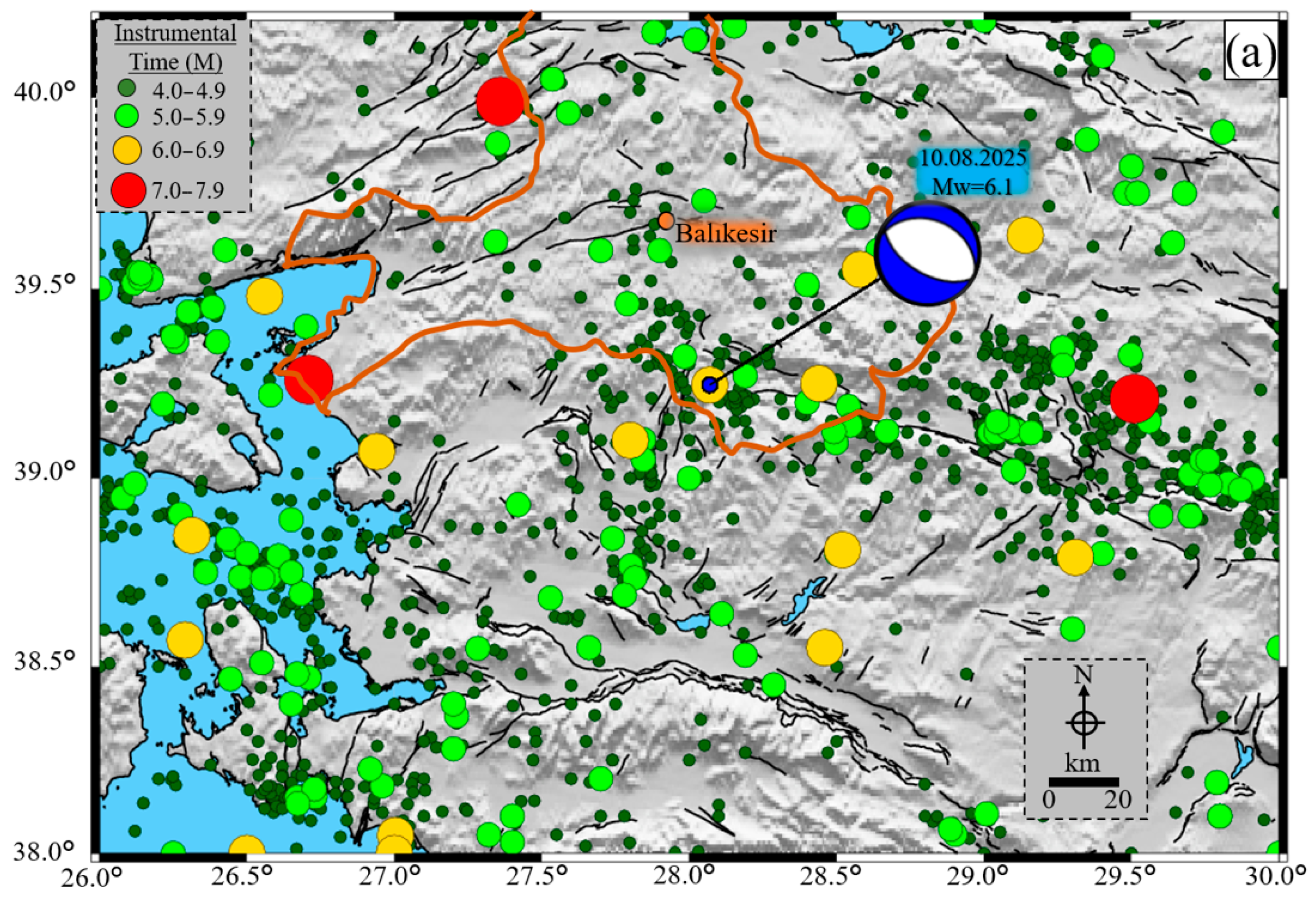
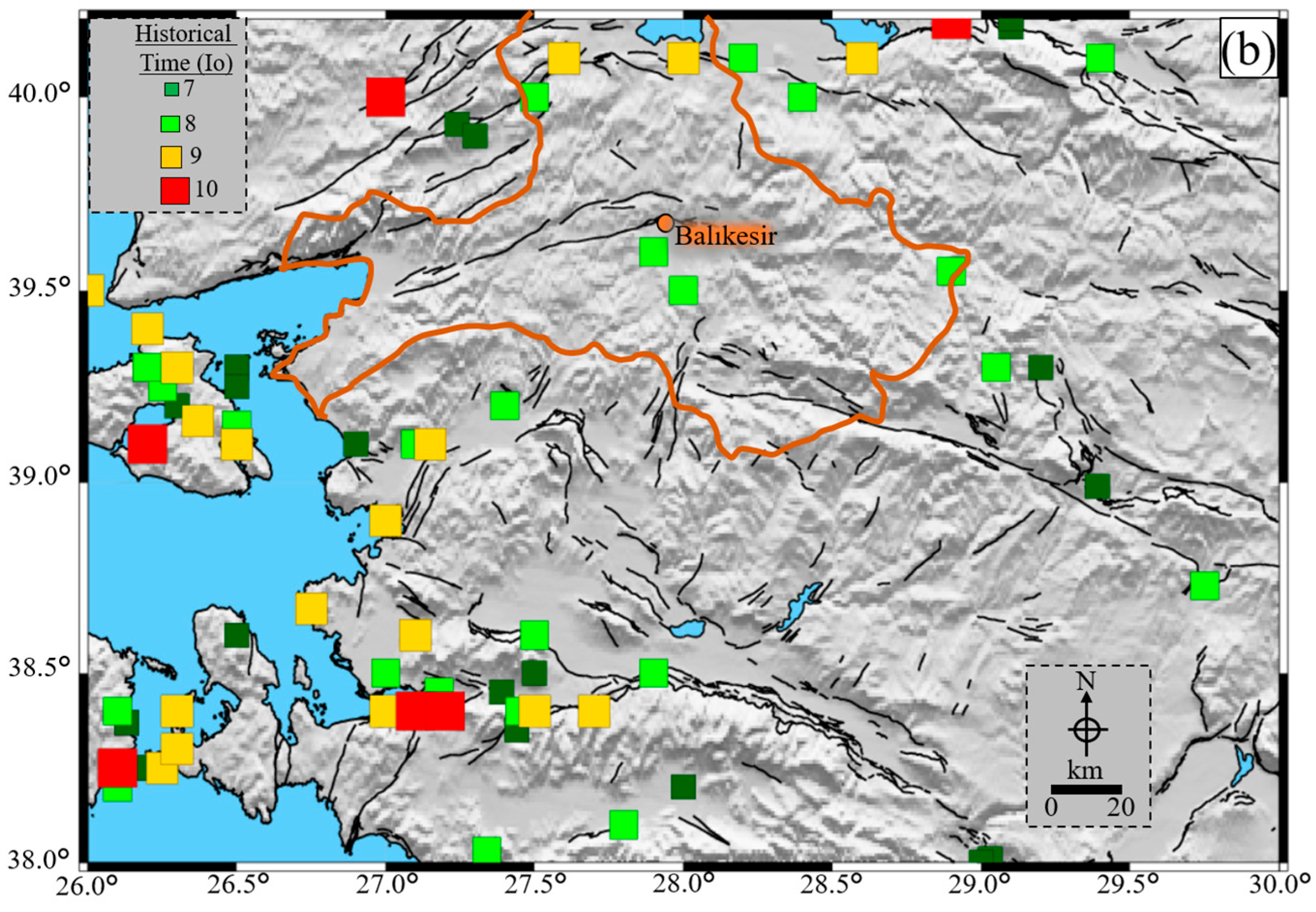
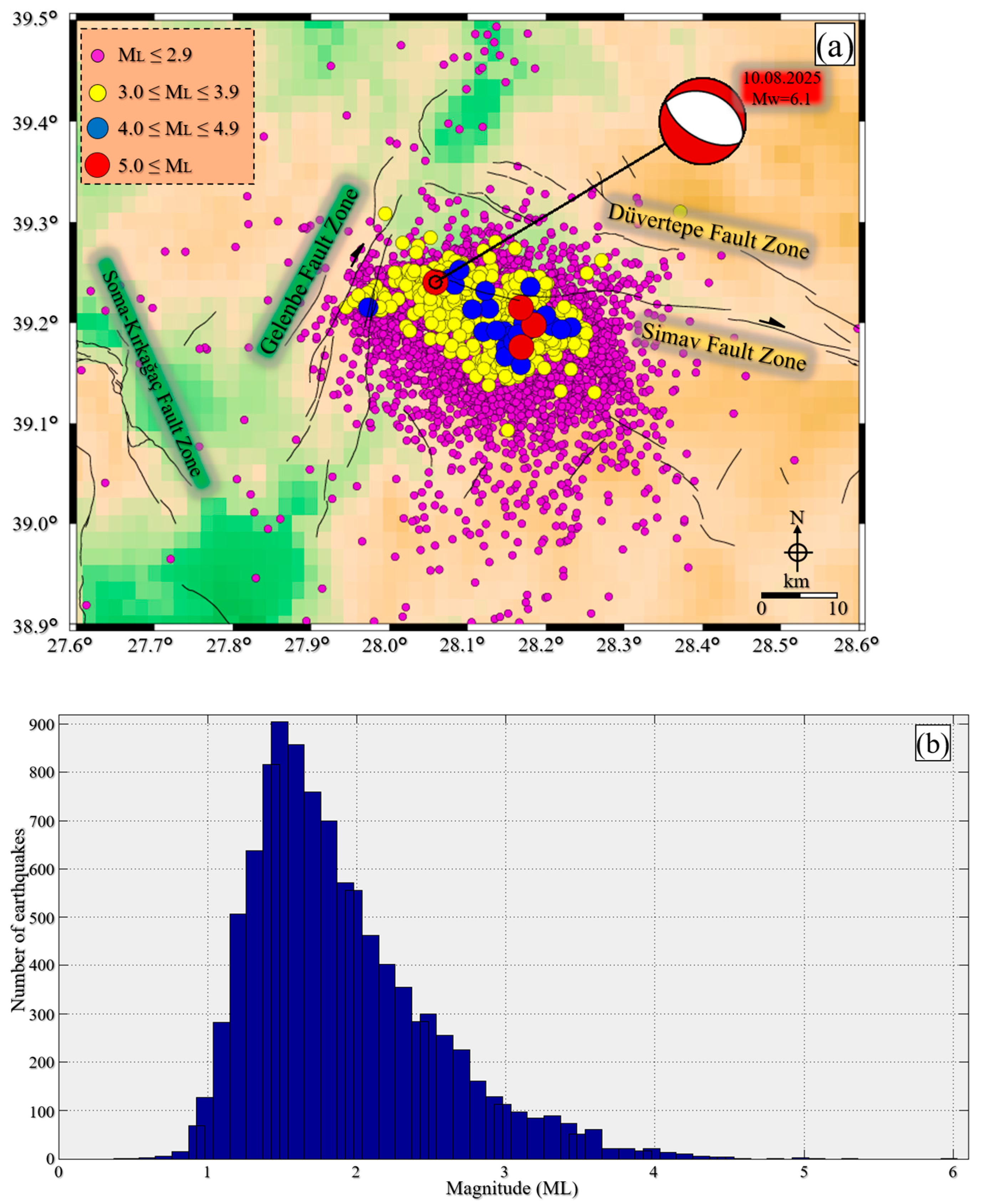
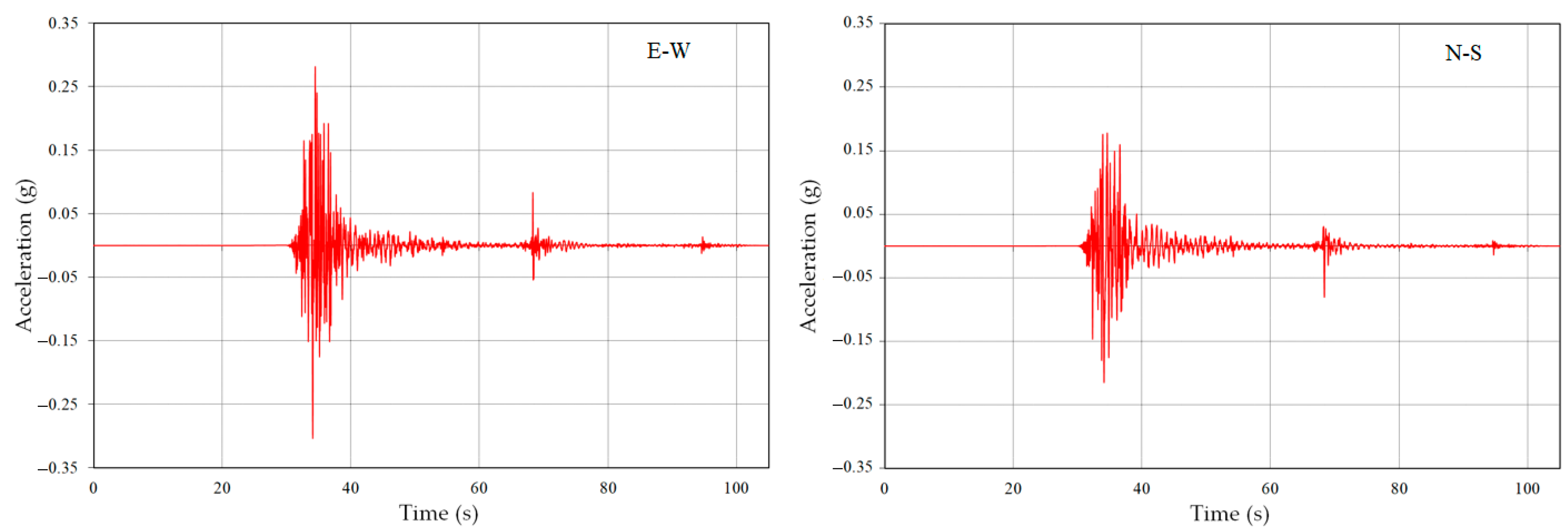

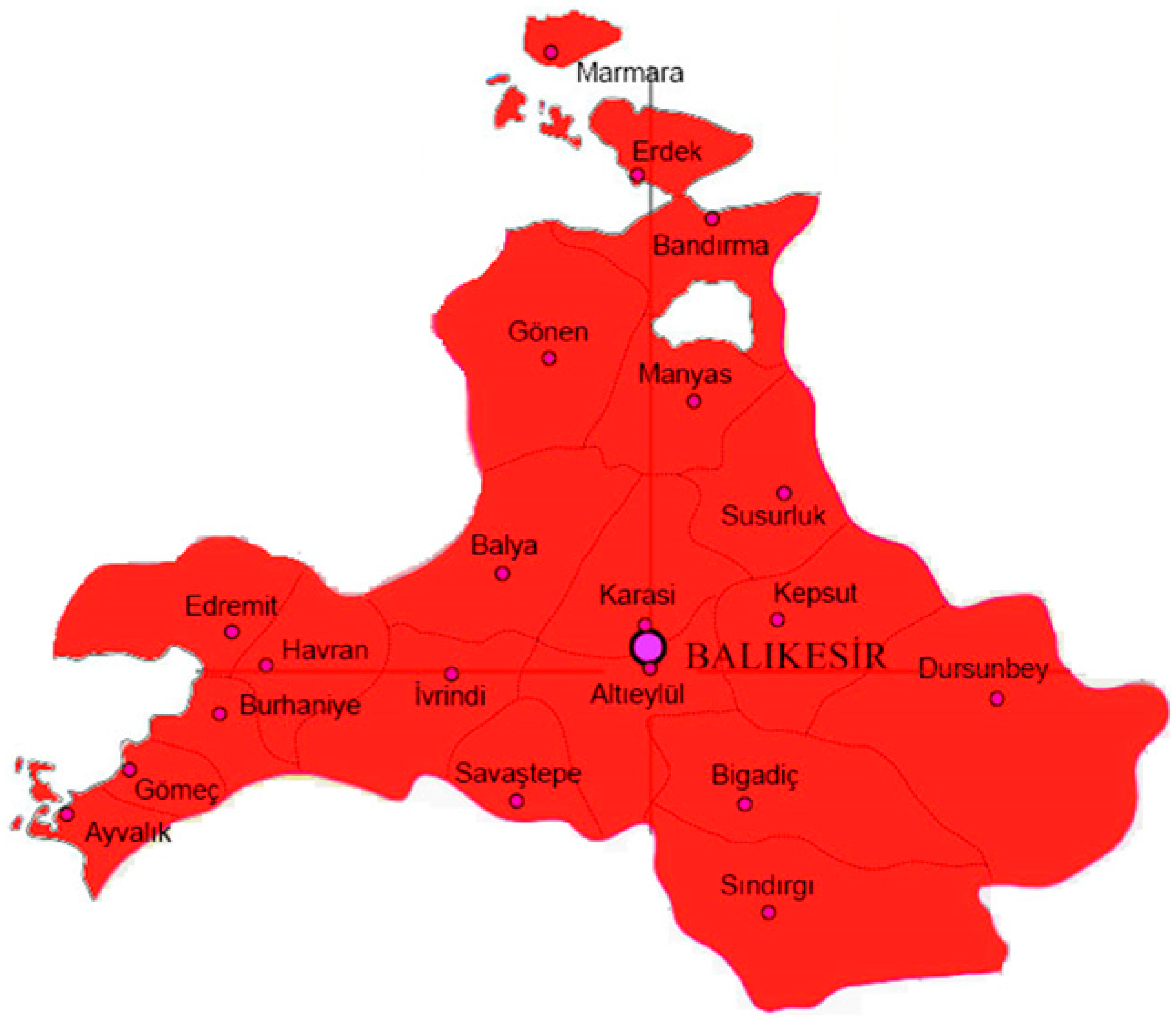

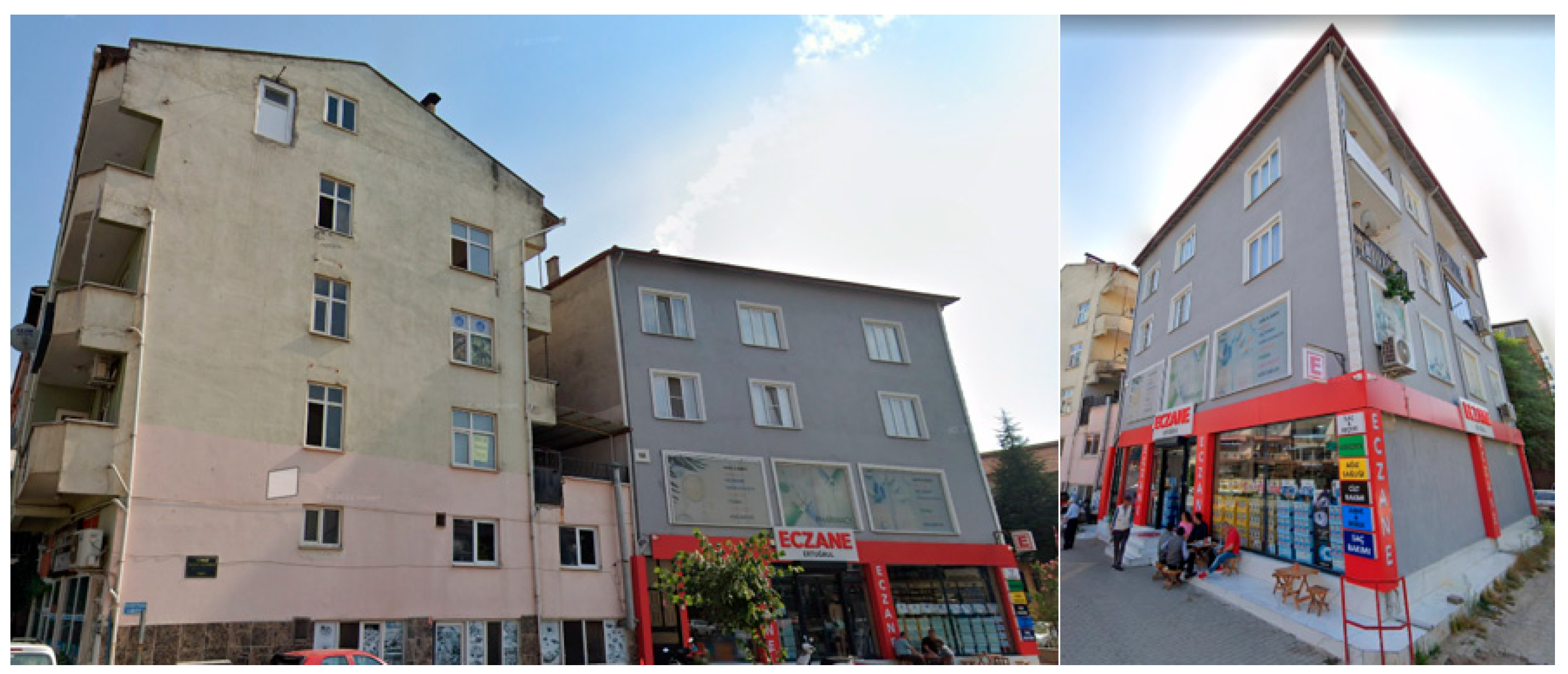





| Stations | Recorded Acceleration Values (gal) | Distance Repi | ||||||
|---|---|---|---|---|---|---|---|---|
| Code | Province | District | Latitude (deg) | Longitude (deg) | N-S | E-W | U-D | (km) |
| 1015 | Balıkesir | Sındırgı | 39.2546 | 28.1644 | 216.67 | 299.39 | 352.92 | 8.78 |
| 1030 | Balıkesir | Bigadiç | 39.3989 | 28.1283 | 161.61 | 176.57 | 113.76 | 17.72 |
| 1016 | Balıkesir | Savaştepe | 39.3804 | 27.6544 | 34.60 | 31.89 | 28.34 | 38.72 |
| 4513 | Manisa | Soma | 39.1892 | 27.6171 | 0.73 | 0.26 | 0.87 | 39.50 |
| 4502 | Manisa | Akhisar | 38.9112 | 27.8233 | 27.37 | 37.25 | 17.04 | 42.88 |
| Earthquake Ground Motion Level | Repetition Period (Year) | Probability of Exceedance (50 years) | Definition |
|---|---|---|---|
| DD-1 | 2475 | 0.02 | Largest earthquake level |
| DD-2 | 475 | 0.10 | Standard-design earthquake ground motion level |
| DD-3 | 72 | 0.50 | Frequent earthquake ground motion level |
| DD-4 | 43 | 0.68 | Service earthquake ground motion level |
| District | PGA (g) | PGV (cm/s) | ||||||
|---|---|---|---|---|---|---|---|---|
| % 2 | % 10 | % 50 | % 68 | % 2 | % 10 | % 50 | % 68 | |
| Altıeylül | 0.685 | 0.372 | 0.152 | 0.11 | 40.711 | 20.902 | 8.522 | 6.357 |
| Ayvalık | 0.668 | 0.368 | 0.156 | 0.116 | 40.327 | 21.266 | 9.007 | 6.848 |
| Balya | 0.680 | 0.366 | 0.144 | 0.102 | 41.033 | 21.139 | 8.450 | 6.180 |
| Bandırma | 0.677 | 0.367 | 0.147 | 0.105 | 41.673 | 22.024 | 8.929 | 6.423 |
| Bigadiç | 0.697 | 0.385 | 0.159 | 0.115 | 40.701 | 21.154 | 8.692 | 6.489 |
| Burhaniye | 0.676 | 0.368 | 0.151 | 0.110 | 41.302 | 21.703 | 8.906 | 6.656 |
| Dursunbey | 0.613 | 0.319 | 0.126 | 0.092 | 36.675 | 18.284 | 7.590 | 5.693 |
| Edremit | 0.747 | 0.413 | 0.16 | 0.114 | 45.865 | 24.892 | 9.634 | 6.928 |
| Erdek | 0.704 | 0.372 | 0.149 | 0.107 | 43.693 | 22.934 | 9.221 | 6.649 |
| Gömeç | 0.701 | 0.384 | 0.157 | 0.115 | 42.064 | 22.228 | 9.178 | 6.888 |
| Gönen | 0.853 | 0.451 | 0.155 | 0.106 | 53.112 | 27.194 | 9.341 | 6.485 |
| Havran | 0.725 | 0.373 | 0.141 | 0.102 | 44.762 | 22.392 | 8.599 | 6.311 |
| İvrindi | 0.713 | 0.376 | 0.145 | 0.105 | 43.611 | 22.007 | 8.525 | 6.317 |
| Karesi | 0.690 | 0.358 | 0.135 | 0.097 | 42.220 | 21.040 | 8.169 | 5.993 |
| Kepsut | 0.673 | 0.345 | 0.132 | 0.096 | 40.680 | 19.964 | 7.920 | 5.873 |
| Manyas | 0.745 | 0.398 | 0.148 | 0.103 | 44.897 | 23.223 | 8.814 | 6.281 |
| Marmara Adası | 0.717 | 0.408 | 0.182 | 0.130 | 47.665 | 26.263 | 11.135 | 7.890 |
| Savaştepe | 0.718 | 0.388 | 0.157 | 0.114 | 41.694 | 21.384 | 8.707 | 6.559 |
| Sındırgı | 0.938 | 0.502 | 0.184 | 0.129 | 57.431 | 29.094 | 9.875 | 7.068 |
| Susurluk | 0.609 | 0.332 | 0.135 | 0.098 | 36.779 | 19.670 | 8.238 | 6.048 |
| District | Earthquake Zone | PGA-2007 (g) | PGA-2018 (g) | Difference (%) | SDS-2007 | SDS-2018 | Difference (%) |
|---|---|---|---|---|---|---|---|
| Altıeylül | I | 0.400 | 0.372 | −7 | 1.000 | 1.062 | 6 |
| Ayvalık | I | 0.400 | 0.368 | −8 | 1.000 | 1.064 | 6 |
| Balya | I | 0.400 | 0.366 | −9 | 1.000 | 1.042 | 4 |
| Bandırma | I | 0.400 | 0.367 | −9 | 1.000 | 1.050 | 5 |
| Bigadiç | I | 0.400 | 0.385 | −4 | 1.000 | 1.097 | 10 |
| Burhaniye | I | 0.400 | 0.368 | −8 | 1.000 | 1.069 | 7 |
| Dursunbey | I | 0.400 | 0.319 | −20 | 1.000 | 0.913 | −9 |
| Edremit | I | 0.400 | 0.413 | 3 | 1.000 | 1.206 | 21 |
| Erdek | I | 0.400 | 0.372 | −7 | 1.000 | 1.061 | 6 |
| Gömeç | I | 0.400 | 0.384 | −4 | 1.000 | 1.120 | 12 |
| Gönen | I | 0.400 | 0.451 | 13 | 1.000 | 1.294 | 30 |
| Havran | I | 0.400 | 0.373 | −7 | 1.000 | 1.073 | 7 |
| İvrindi | I | 0.400 | 0.376 | −6 | 1.000 | 1.070 | 7 |
| Karesi | I | 0.400 | 0.358 | −11 | 1.000 | 1.020 | 2 |
| Kepsut | I | 0.400 | 0.345 | −14 | 1.000 | 0.984 | −2 |
| Manyas | I | 0.400 | 0.398 | −1 | 1.000 | 1.130 | 13 |
| Marmara Adası | I | 0.400 | 0.408 | 2 | 1.000 | 1.193 | 14 |
| Savaştepe | I | 0.400 | 0.388 | −3 | 1.000 | 1.103 | 10 |
| Sındırgı | I | 0.400 | 0.502 | 26 | 1.000 | 1.428 | 43 |
| Susurluk | I | 0.400 | 0.332 | −17 | 1.000 | 0.958 | −4 |
| District | PGA (g) | TSDC-2007 | Satisfied? | TBEC-2018 | Satisfied? |
|---|---|---|---|---|---|
| PGA (g) DD-2 | PGA (g) DD-2 | ||||
| Balya | 0.020 | 0.400 | √ | 0.366 | √ |
| Bandırma | 0.029 | 0.400 | √ | 0.367 | √ |
| Bigadiç | 0.180 | 0.400 | √ | 0.385 | √ |
| Burhaniye | 0.023 | 0.400 | √ | 0.368 | √ |
| Dursunbey | 0.200 | 0.400 | √ | 0.319 | √ |
| Edremit | 0.200 | 0.400 | √ | 0.413 | √ |
| Erdek | 0.007 | 0.400 | √ | 0.372 | √ |
| Havran | 0.017 | 0.400 | √ | 0.373 | √ |
| İvrindi | 0.023 | 0.400 | √ | 0.376 | √ |
| Karesi | 0.048 | 0.400 | √ | 0.358 | √ |
| Kepsut | 0.048 | 0.400 | √ | 0.345 | √ |
| Manyas | 0.031 | 0.400 | √ | 0.398 | √ |
| Savaştepe | 0.035 | 0.400 | √ | 0.388 | √ |
| Sındırgı | 0.360 | 0.400 | √ | 0.502 | √ |
| District | PGA (cm/s2) | MMI | |
|---|---|---|---|
| Bayrak [60] | Büyüksaraç et al. [61] | ||
| Balya | 19.08 | V | V |
| Bandırma | 28.16 | VI | VI |
| Bigadiç | 176.57 | VIII | VIII |
| Burhaniye | 22.98 | VI | VI |
| Dursunbey | 19.70 | V | V |
| Edremit | 20.09 | V | V |
| Erdek | 6.62 | IV | IV |
| Havran | 16.19 | V | V |
| İvrindi | 22.51 | VI | VI |
| Karesi | 47.68 | VII | VII |
| Kepsut | 46.67 | VII | VII |
| Manyas | 30.10 | VI | VI |
| Savaştepe | 34.61 | VI | VI |
| Sındırgı | 352.93 | IX | IX |
Disclaimer/Publisher’s Note: The statements, opinions and data contained in all publications are solely those of the individual author(s) and contributor(s) and not of MDPI and/or the editor(s). MDPI and/or the editor(s) disclaim responsibility for any injury to people or property resulting from any ideas, methods, instructions or products referred to in the content. |
© 2025 by the authors. Licensee MDPI, Basel, Switzerland. This article is an open access article distributed under the terms and conditions of the Creative Commons Attribution (CC BY) license (https://creativecommons.org/licenses/by/4.0/).
Share and Cite
Büyüksaraç, A.; Avcil, F.; Alkan, H.; Işık, E.; Harirchian, E.; Özçelik, A. Seismic Hazard Implications of the 2025 Balıkesir Earthquake of Mw 6.1 for Western Türkiye. GeoHazards 2025, 6, 64. https://doi.org/10.3390/geohazards6040064
Büyüksaraç A, Avcil F, Alkan H, Işık E, Harirchian E, Özçelik A. Seismic Hazard Implications of the 2025 Balıkesir Earthquake of Mw 6.1 for Western Türkiye. GeoHazards. 2025; 6(4):64. https://doi.org/10.3390/geohazards6040064
Chicago/Turabian StyleBüyüksaraç, Aydın, Fatih Avcil, Hamdi Alkan, Ercan Işık, Ehsan Harirchian, and Abdullah Özçelik. 2025. "Seismic Hazard Implications of the 2025 Balıkesir Earthquake of Mw 6.1 for Western Türkiye" GeoHazards 6, no. 4: 64. https://doi.org/10.3390/geohazards6040064
APA StyleBüyüksaraç, A., Avcil, F., Alkan, H., Işık, E., Harirchian, E., & Özçelik, A. (2025). Seismic Hazard Implications of the 2025 Balıkesir Earthquake of Mw 6.1 for Western Türkiye. GeoHazards, 6(4), 64. https://doi.org/10.3390/geohazards6040064









